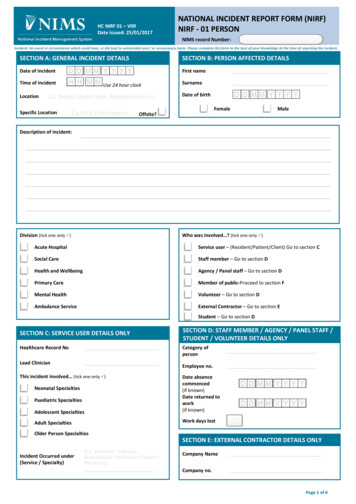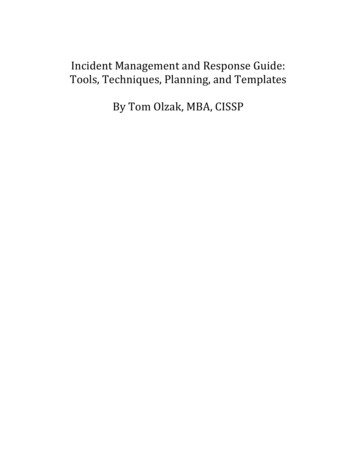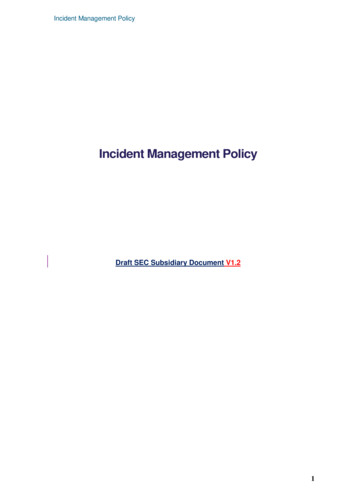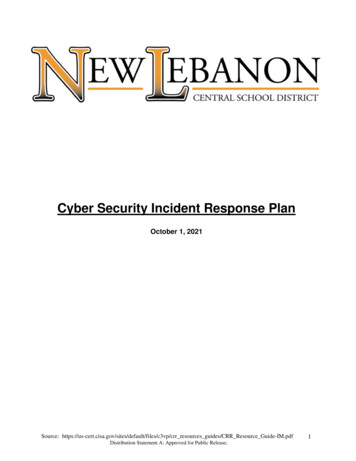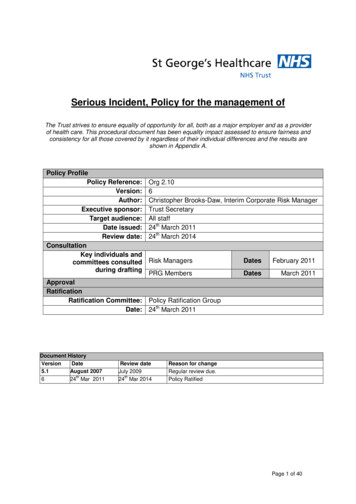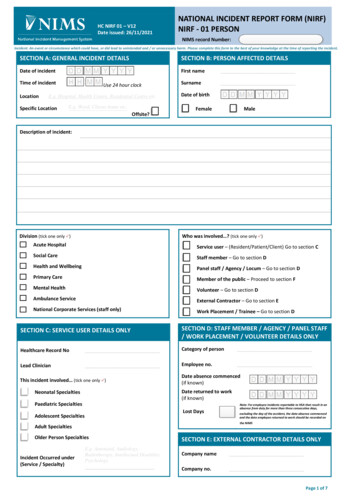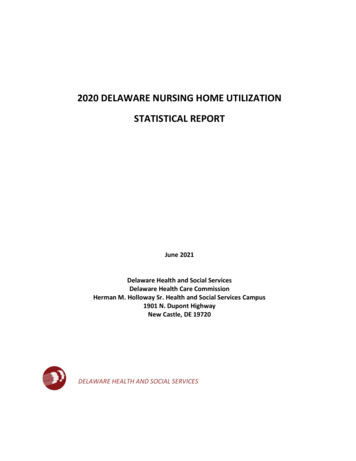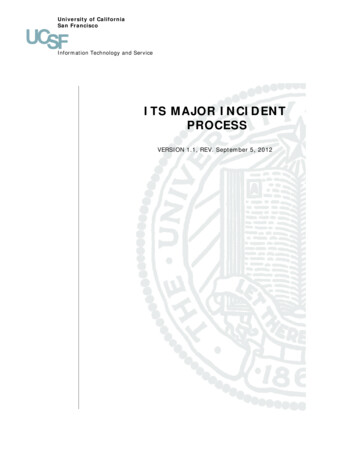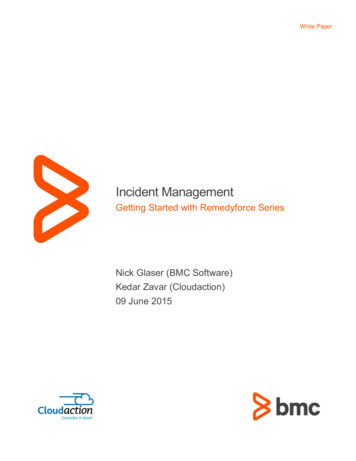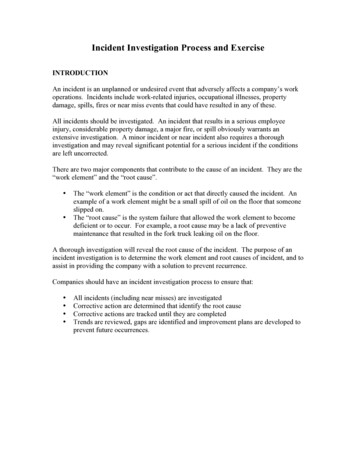
Transcription
CRITICALINCIDENTREPORTINGDELAWARE DIVISION OF SUBSTANCE ABUSE ANDMENTAL HEALTH (DSAMH)PROMISE PROGRAM
WHAT IS A CRITICALINCIDENTAny actual or alleged event or situation that creates a significantrisk of substantial or serious harm to the health or welfare of aclient.Could have or had a negative impact on the mental and/orphysical well being of a client in the short or long term.
WHY DOES THE STATENEED TO TRACKCRITICAL INCIDENTS To assure that necessary safeguards have been taken to protectthe health and welfare of the individuals receiving 1115 waiveramendment services To identify, address and seek to prevent the occurrence of abuse,neglect and exploitation on a continuous basis To comply with key regulatory requirements from CMSregarding monitoring To insure remediation (follow up) actions are initiated whenappropriate
CRITICAL INCIDENTS AND THEDEPARTMENT’S QUALITYIMPROVEMENT STRATEGYMonitoring Critical Incidents is a part of theDepartment’s Quality Improvement Strategyencompassing three functions: Discovery Remediation (Follow-Up) Continuous Improvement
PROVIDERS OFWAIVER SERVICESWaiver services are furnished at widely dispersedsites throughout the state and communitiesTypically include: large and small private-sectorprovider organizations, case managers,individual personal assistants and attendants,clinicians, neighbors and other communitymembers who support individuals
REPORTING ISSUES Some providers are very diligent about reportingcritical incidents to DSAMH Some agencies understand the Critical IncidentReport (CIR) reporting process and expectations welland others do not Some agencies under-report incidents Some DSAMH providers have a high frequency ofcritical incidents while others have a low frequency
TIMELY REPORTINGREQUIREMENTSHCBS Waiver Service Provider( within 24 hours or one business day)Conflict Free Care Managers( within 24 hours or one business day)Follow-up and investigation DSAMH responsibility? Provider responsibility? Other entity Responsibility?
PROVIDERREPORTING FORMSProvider Services provider services forms DSAMH CriticalIncident Reporting FormsHCBS Provider Critical Incident Information Form
TYPES OF CRITICALINCIDENTS TO REPORT Deaths Suspected Abuse/Neglect/Exploitation Serious Illness Injury to Client Damage to Client’s Property or Theft Medication Management Issues ie., Errors/Omissions Other High Risk Issues
DEATH TYPESOngoing Medical Condition/Illness/DiseaseNew Medical Condition/IllnessUnexpected/Unknown CauseCompleted SuicideHomicideAccidental DeathOther
SUSPECTED ABUSE,NEGLECT, OREXPLOITATION Abuse includes actions which result in bodily harm, pain or mentaldistress. Neglect is a failure to provide care and service when a waiver client isunable to care for him or herself. Exploitation is the deliberate misplacement, exploitation, or wrongfultemporary or permanent use of a client’s belongings or money withoutthe client’s consent.
SERIOUS MEDICAL ILLNESS Recurring Illness Heart attack (MI) Stroke (CVA) Pneumonia Respiratory failure Seizure Infection (UTI) Dehydration Cancer Diabetic Crisis Mental Illness symptoms Medical crisis Other illnessCritical Incident Reports Expected In Circumstances That Would Lead ToThe Belief Of A Higher Risk Potential To The Individual
CAUSES OF SERIOUSILLNESS New medical condition Existing medical condition Treatment error Medication or Omission of Medication Poor care Undetermined Other
SERIOUS INJURYFracture/DislocationLacerationSerious BurnHead InjuryMultiple injuriesUnknown injury from fall requiring medical attentionUnknown injuryOther injury
CAUSES OF irationPhysical RestraintUndeterminedOther
DAMAGE TO CLIENT’SPROPERTY / THEFT Deliberate damage, destruction, theft, misplacementor use of a client’s belongings or money without theclient’s consent, including the deliberate diversion ofmedications
MEDICATIONMANAGEMENT Problems with medication dosage, scheduling,timing, set-up, compliance, administration ormonitoring which can result in documented harm oran adverse effect which necessitates medical care. Event Type Cause for event Administered by
OTHER HIGH RISKINCIDENTSSerious issues that do not yet rise to the level of acritical incident, but have the potential to do so inthe future, including such events such asenvironmental hazards, suicide threats, selfinjurious behaviors, arrest or detention, etc.This type of critical incident always requiresfollow-up. May start out as a general incident butrises to critical.
TYPES OF HIGH RISKISSUESLost/missing personLoss of Home/EvictionClient fraudProvider fraudSerious criminal offense(offense by client)Client abuse toward othersUnusual aggressive behaviorSuicide ideationSuicide attemptSubstance abuseMedia involvementEnvironmental hazardRestraints used
COMMON REPORTINGITEMS1. Hospitalizations2. ER Visits3. Dr. Visits4. Law Enforcement Involvement
RECORDING A CRITICALINCIDENT REPORTWhen reporting a critical incident, be prepared toprovide enough information so the reviewer knows: Who was involved in the incident What were the circumstances of the incident - details Where the incident happened When the incident took place, Date & Time
MANDATORY REPORTINGRESPONSIBILITIESReporting Critical Incidents to DSAMH does notrelieve the provider, provider agency or others of otherforms of mandated reporting, including reports to lawenforcement, Adult Protective Services, or Long TermCare
AFTER A CRITICALINCIDENT IS REPORTEDDSAMH Risk Management Staff will review all CIRSreports on daily basis checking for completeness ofreports to determine if the report: Provides enough detail to understand the circumstancesof the incident Documents the steps taken to respond to incident Identifies how client’s safety has been addressed and thefollow-up measures taken and/or planned Documents whether mandatory reporting has occurred
AFTER A CRITICALINCIDENT IS REPORTEDThere will be instances when additional follow-up bythe DSAMH Risk manager will be required: when reports lack sufficient information for thereviewer to understand the nature of the incident how a client or situation has been stabilized what safety measures have been taken to investigateand remedy the circumstances
COMPLETE EVERY SECTIONREFER TO INCIDENT REPORT ON TABLES
WHERE TO SEND THECIRA special email box at DSAMH has been set up calledIncidents and Concerns.Be certain you are reporting Timely within 24 hours.Questions?
Thank-you!Upon completion of this curriculum, please send your name and that of yoursupervisor to the e-mail box: dsamhpromise@state.de.us as proof of your taskcompletion.Thomas Johnson Director Provider Relations UnitDivision of Substance Abuse and Mental Health1901 North DuPont Highway New Castle, DE 19720Tel (302) 255-9463 Fax (302) 255-4428 Rm 178 re: tom.johnson@state.de.us
critical incident, but have the potential to do so in the future, including such events such as environmental hazards, suicide threats, self-injurious behaviors, arrest or detention, etc. This type of critical incident always requires follow-up. May start out as a general incident but rises to critical.
